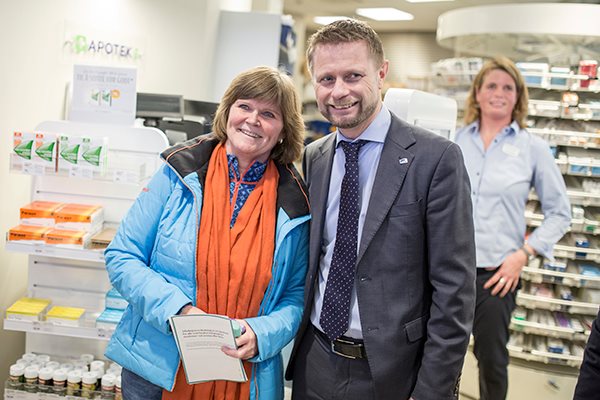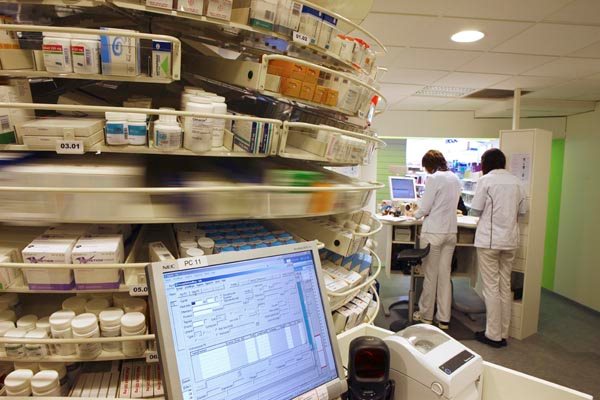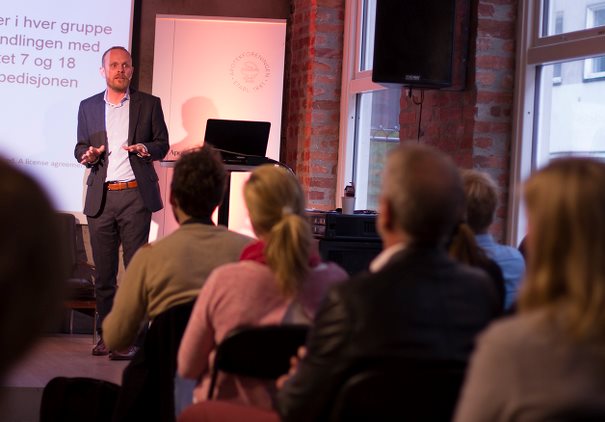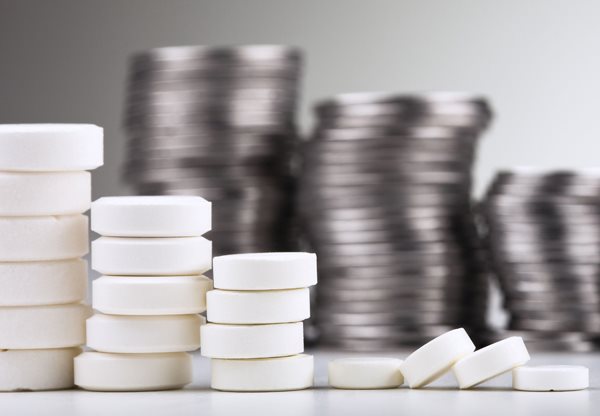

For the first time, patients can receive a service paid for by the Norwegian National Insurance Scheme. This has led to 50,000 conversations with pharmacists counselling asthma and COPD patients throughout the first year. We have heard of countless patients who have managed to catch their breath again, so to speak, after these conversations. I am proud and impressed by the effort being made on behalf of this patient group at pharmacies.
Read CEO Per T. Lund's summary of 2016.
Parliament believes that pharmacists' expertise must be of more benefit to patients. The pharmacies are a vital low-threshold resource, parliamentarians underscored, when examined the parliament The Medication Treatment Paper. They want to see more patient counselling taking place in pharmacies.
Parliament is of course right. That is why last year we also presented the results of the Medicine start, demonstrating that large patient groups will greatly benefit from exactly the type of advising services which Parliament is calling for. In practice, starting a medication will be "the patient's health service". 2017 will reveal whether the government and Parliament will follow up on their politics in earnest.
It is essential to focus on new services at pharmacies to ensure that patients properly use their medications. However, we shouldn't forget the fact that the pharmacies already provide thorough advising. Last year we logged which pharmacy services were performed and quantified how often they occurred. The numbers were quite large. You can read more on this below.
Furthermore, I think that 2016 will be remembered as the year of the kick-off of a new IT-solution for pharmacies. In this regard, all the pharmacies are working together for a new solution which, among other things should provide better solutions for handling prescriptions, reimbursement, medical record keeping and pharmaceutical services. We'll be hearing a lot more about this in the near future.
An important document for those of us who deal with the pharmacies' framework conditions was given to the Ministry of Health and Care Services from The Norwegian Medicines Agency. The assessment of the pharmacy mark-up scheme and stepped price system model has become a good starting point for the Minister of Health, one which can be drawn upon when he will need to propose changes to the structure of the pharmacy mark-up scheme for Parliament in autumn.
2016 was an active year politically for the pharmacy sector, thanks in large part to the The Medication Treatment Paper. Today, I assess the pharmacy industry’s position as very strong, a position from which we favourably enter 2017. I'm looking forward to what's next on the horizon.
Three out of four say that they are extremely satisfied with the pharmacy they normally use
Well over half of us have bought prescription medications when we were at the pharmacy
Good customer service and information is vital to us when we're at the pharmacy
The results from the autumn 2016 Apotekbarometeret [Pharmacy barometer] are testament to this. There are slight variations in the numbers compared to the last evaluation and the results are primarily very positive.
Trust surrounding pharmacies is still at the same high level. Satisfaction with individuals' primary pharmacies has never been measured to be higher. There are still very few people who hold the opinion that pharmacies are only interested in profits. There's a steadily increasing proportion of people who state that they always, or generally, get information on how they should use their medication. In terms of negatives, we're registering that a few more people don't get hold of all the medications they need at the pharmacy. Analysing this in terms of the percentage of medications dispensed, we see a fall from 95 to 93 percent from the analysis in April.
Along with 14 other organizations, The Norwegian Pharmacy Association participated in the KANTAR TNS Health-politics barometer, which was conducted for the very first time last year. To some degree, the study has contributed to placing pharmacies into a larger health politics perspective. The main results from the surveys regarding pharmacies are:

This service was officially launched on 3 March by Minister of Health Bent Høie at the pharmacy Apotek 1 at Nordstjernen in Oslo. In the course of the ten months in 2016 during which the service was available at the pharmacies, more than 40,000 inhaler technique instructional services took place. Initial research shows that 7 out of 10 patients who recieved the serivce were not correctly administering their inhaled medicines and recieved aid to correct their technique.
The objective for this service is that asthma and COPD patients will develop better inhaler techniques and thereby benefit more optimally from their medication. The service is available free-of-charge to patients and the pharmacy is paid a fee by the state.
In cooperation with Apokus, the Norwegian Pharmacy Association on 1 March, 2017 provided its evaluation of the service Checking inhaler technique to the Norwegian Directorate of Health.
Here are some of the findings from the Norwegian Pharmacy Association’s report:
The evaluation report is based on results from several studies. The main study recruited 405 patients from 42 pharmacies to analyze the reduction in inhaler technique errors after the service had been performed at the pharmacies.
In the study, the participating pharmacists used checklists delineating all the steps of the inhalation procession which the patient must perform correctly. The study showed that prior to being instructed by a pharmacist in the pharmacy, only 5 percent of the patients did everything correctly when using Turbuhaler. After counselling, approx. 76 percent of the patients used Turbuhaler correctly.
Half of the patients who were offered Inhaler Technique Instruction said yes to being provided with the service. The study also demonstrated that patients who received the service were extremely satisfied. On a scale from 1–5, the patients gave on average a score of 4.2 regarding whether they felt the service was useful to them and 4.4 for how satisfied they were with the service.
The same patients who participated in the first part of the study will return in 3 months in order to see whether their correct inhaler technique has been maintained. As of now, these results are not ready.
Check out the campaign page for more information on how the Inhaler Technique Instruction service is performed in pharmacies.

Via its subsidiary, the Norwegian Pharmacy Association will acquire a new common IT-solution on behalf of all pharmacies. The goal is to produce a cost-effective and safe solution enabling pharmacies to dispense prescriptions and perform pharmaceutical services such as advising, instructing and patient follow-up.
The undertaking of finding a supplier to develop the new solution started in 2016. A competition was advertised in accordance with the rules on public procurement.
The new industry solution will collect information from public systems, as well as register and make it accessible to pharmacies. Reporting from the pharmacies to online systems will also be accomplished through this new solution. System support for prescription and administration of medications at pharmacies will be an essential component. The solution must cover three functional areas which are today found in FarmaPro administration of prescriptions, refunds and reporting. What's more, new areas will be developed for which there is currently little to no system support for in pharmacies: information and advising, pharmaceutical services, medical records keeping and the forgery directive.
The solution will partially replace the current pharmacy management software solution, "FarmaPro", which is administered by Espire. The acquisition will also entail the sale of Espire AS to the supplier.
The announcement of the acquisition was placed onto Doffin – the national announcement database for public acquisition – in November.
In 6 out of 10 prescription transactions with customers, the customer is given information which exceeds the standardized pharmacist check.
Up to 1 million prescriptions per year contains errors or are inadequate in some way that must be fixed
In more than 10% of the customer prescription transactions, there's an event which requires extra effort from the pharmacy staff
Why does it take time to dispense a prescription? What are you actually doing behind the counter at the pharmacy?
People who've had to wait some minutes with queue tickets in hand often ask.
In order to address these questions well, The Norwegian Pharmacy Association tasked the Apokus diagnostic centre with finding a representative sample of pharmacies to register all of the additional assignments they did during 40,000 prescription transactions in 2016.
- Assuming that this is cross-section of all pharmacies, we can now say how much time it takes the pharmacists to handle a prescription and dispensing medications. The numbers are quite large considering the fact that there are roughly 30 million medication dispensements annually at the 872 pharmacies we have in Norway, notes Per Kristian Faksvåg, principal director at the Norwegian Pharmacy Association.
In addition to the three findings above, the main results from the log study on pharmacy services in 2016 are as follows:
don't have a prescription when they come into the pharmacy or cannot identify themselves
get advising on follow-up and management of side effects
between various medications are handled by the pharmacy staff
of duplicate prescriptions, where the patient has two prescriptions for two similar medications, are discovered each year at pharmacies
every pharmacy has to call the doctor due to an error or something missing on the prescription
the pharmacy doesn't get through to the doctor
explaining generic substitution of equivalent medications
explaining how to correctly use a medication
where the pharmacy staff demonstrate the practical use of a medication

On 13 October, two years after the research project Medicine Start (equivalent to the New Medicine Service) was launched, the Norwegian Pharmacy Association and Apokus presented the first results from the randomized controlled study. Among other things, the results show that patients who take statins for high cholesterol benefit greatly from the service, increasing the adherende with 10% compared to the control group.
The Norwegian Pharmacy Association is aiming to get public remuneration for the service so it can be offered to patients in the pharmacies. The Norwegian Health Directorate assess the results of the Medication Start study and evaluation of Checking inhaler technique and present their recommendations to the Royal Norwegian Ministry of Health and Care Services in 2017.

The Norwegian Medicines Agency presented its evaluation in December of the pharmacy mark-up scheme and stepped price system to the Royal Norwegian Ministry of Health and Care Services (HOD). They open up to the possibility of i.a. altering the pharmacy mark-up scheme in the direction of a higher Norwegian crown surcharge and a lower percent surcharge, in addition to stating that the stepped price system should be maintained. This is in line with the input given by the pharmacy industry.
HOD is expected to follow up on the report in 2017 and that adjustments will be made according to the state budget for 2018.Politicians got involved in this issue, as well as in the Medication Shortage in 2016. Parliamentarian Ketil Kjenseth (V) said in an article on apotek.no that "[he] want[s] an annual report for Parliament on the development of medication shortages"

A new electronic settlement scheme for H-prescriptions has been developed. Pharmacies send settlement requests to The Norwegian Health Economics Administration (HELFO), which examines the request and subsequently pays out a settlement on behalf of the health trusts. The H-prescription agreement has been renegotiated in connection with the establishment of the electronic settlement scheme for H-prescriptions. The agreement entered into force on 24 October, 2016. All pharmacies which were under the old agreement have been automatically transported to the new agreement.
The H-prescription scheme was established in 2006 as a result of parliamentary enactments which determined that the financial responsibility for TNF-α-inhibitors used outside hospitals should be transferred from national insurance to the Specialised services. This scheme has subsequently been expanded for multiple therapeutic areas. In 2016, the value of turnover for H-prescription medications was NOK 3.3 billion.
In 2016 we used medications costing more than NOK 25 billion
94 percent of us live in a municipality with at least one pharmacy
At the end of 2016, there were 868 pharmacies
Last year we consumed medications, amount to a cost of more than NOK 25 billion in Norway. This corresponds to each of us spending, on average, NOK 4,762 worth of medications. The public paid NOK 3,500 of this cost, mainly through national insurance and the hospitals.
The consumption of medications increased by 1.9 percent per resident. The value of turnover for medications increased approx. 8.8 percent from 2015. The main explanation for the price increase is that multiple more expensive medications have come into the picture. It has also become more expensive to import medications in Norway due to the weak Norwegian crown.
There is generally speaking good accessibility to medication in Norway. At the start of the new year, there were 868 pharmacies, and 94% of us reside in a municipality that has at least one pharmacy. Every day 160,000 customers enter a pharmacy.
Apotekforeningen © 1999-2024
Slemdalsveien 1, Postboks 5070 Majorstuen, 0301 Oslo
Tlf: +47 21 62 02 00
Nettredaktør: Vendil Åse
Designed by Design Container Developed by 07 Interaktiv